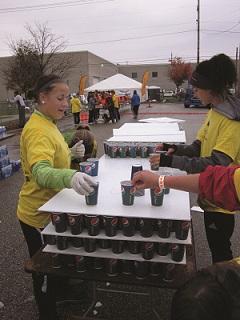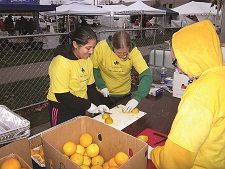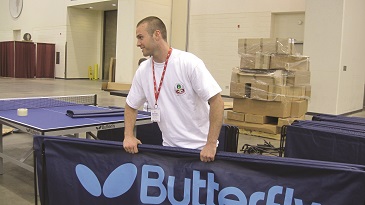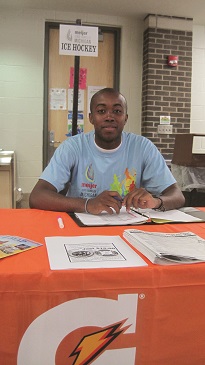

Despite these challenges, a well-run volunteer program not only is possible – it can be a fairly smooth process with some advanced planning and foresight. When I look at how we’ve grown in our volunteer coordination efforts over the years, certain lessons rise to the top in terms of how to recruit, engage and get the most out of your volunteers.
Put leaders in place at the top.
The best volunteer program begins with placing leaders in a few key positions, both at the sports commission and the sporting event itself. At the West Michigan Sports Commission, we book 60-plus sporting events per year – and at least half of these require some form of volunteer support. I’m sure we’re typical of sports commissions who are the local resource for assisting in engaging the community in sporting events.
We don’t take this task lightly, which is why our events manager, Katy Tigchelaar, manages volunteer support as a primary function of her job description. The support we provide ranges from finding as few as three volunteers to help set up a Michigan high school fencing championship; to recruiting, training and supervising 300 volunteers for a one-day 5K event; to managing an entire volunteer operation that includes 1,000 volunteers for the annual Meijer State Games of Michigan.
Recruit a lead volunteer for large-scale events.
While a local organizing committee may be managing the volunteers, you should be prepared for events where this isn’t the case, starting with recruiting a volunteer coordinator for large-scale events. Make sure the volunteer coordinator is passionate about your event and has a personal connection. This is a key part of the position’s success, as there needs to be a motivation for someone to give hundreds of hours of personal time to an event.
When we took on responsibility for the Transplant Games of America, we brought in a community member named Patty Alexander because we knew her volunteer ethic from other events and that she had a personal passion for sports (her son played hockey at the high school, college and pro levels.) In addition, she was touched personally by the event mission, with four family members undergoing heart transplants. As Patty says, “I believed in the event and wanted it to be successful, so it was easy to sell working on it to volunteers because I was passionate about it.”

When it comes to staffing sporting events, it is much easier to contact people who have already expressed interest than it is to recruit from scratch. In our case, our database of volunteer prospects has grown from 500 names a few years ago, to 2,000 names today. This was possible because we recruit year-round for volunteers. Some ways to do this:
-
Secure an information booth at annual events such as college and community expos. We have had great success in signing up local college students for our event newsletter about volunteer opportunities (free-tee-shirts are always a popular incentive).
-
Recruit at places where people have a natural connection to your cause or event. Local sporting events like 5K runs usually provide exhibit space and should deliver a pre-qualified crowd since attendees already care about sports. If your event is tied to a health cause, consider where people naturally have an interest that issue, such as hospitals.
-
Turn to your local sporting clubs as a recruitment target, especially those related to the sporting event at hand. Chances are, they are involved already as part of the local organizing committee that was a criterion of the bid process – but if not, it should be an automatic step to contact sporting clubs associated to a sport.
-
Keep volunteer prospects engaged through ongoing communications. Once people have expressed interest in volunteering, check in with them regularly to remind them of opportunities. We send out e-newsletters twice a month detailing upcoming sporting activities in West Michigan that need volunteers. While not everyone will sign up for something every time, it generates interest and keeps people engaged.
Understand the event.
Once it is time to staff up volunteers for a specific event, take time at the beginning to make sure they know the event itself – not only the sport, but also the venues and their unique needs.

Use volunteers to help personalize the event experience. Your volunteers are on the front line, literally serving as the face of the event. So while a sign might do the job, a personal greeter might make the event more friendly and welcoming.
Consider the event magnitude when determining volunteer needs. For example, with one of our largest events, the lead volunteer was able to assess her need for a right-hand support person to help her with volunteer management.
Make it easy for people to say yes.
Once you have built a database of volunteer prospects and assessed the volunteer needs for your particular event, make it easy for people to get involved:
-
Make volunteer recruitment a key message in your marketing tools. That may mean creating a newsletter, e-mail alerts, and a dedicated section on your website.
-
Be specific with your needs. Specify in your request for volunteers the duties, length of time and other requirements.
-
Don’t recruit too early. This relates to the earlier point – if you recruit too early for specific events, you may not have all the details yet, which often don’t become evident until closer to your event (three to four months out for a large annual event). Another reason not to recruit too early – people are less likely to drop out because they forget they made the commitment.
-
Consider payment if all else fails. Some organizations employ this technique to attract volunteers who might be hard to recruit otherwise. While this should be carefully considered since it can set a precedent that is difficult to change later, it can be effective for a first-time event that doesn’t have a following or one that needs many volunteers. Our commission has assisted groups in filling slots this way on occasion, reaching out to athletic directors of area schools who are looking for fundraising projects for their booster groups as an example.

Just as important as it is to make the process easy for volunteers, it needs to be easy for the volunteer coordinator to manage details.
-
Create a system to track volunteers from the moment they sign up for more information. For example, when our team attends expos to recruit volunteers, we add people on the spot electronically to our database so that they automatically receive the next newsletter.
-
Automate volunteer registration. Our volunteer newsletter includes hyperlinks at the bottom of each event description that jump to an online registration page, automatically putting them into a database and/or sending an e-mail to the event coordinator, depending on who is coordinating volunteers.
-
Consider free online management tools like Volunteerspot.com (free or nominal monthly fee for added features). These allow you to track every aspect of a volunteer program, including volunteer contact information, volunteer positions, event schedules and other details. Once the data is entered, it can be manipulated to run reports or to send group e-mails to volunteers with information including orientation invitations or shift reminders.
Plan contingencies.
As the saying goes, the best laid plans still can go awry, and a volunteer program is no different. Inevitably, someone will not show up for a shift, he or she will not like the job or he or she won’t be a fit for the position. That’s where flexibility comes into play. Some tips:
-
Staff some volunteers as floaters. These are volunteers who don’t have a specific assignment but will do whatever is needed. That way if someone can’t make their shift or doesn’t like their assignment, one of these team members steps in to help. For example, an entire flex crew of volunteers worked at the Transplant Games and did a little bit of everything.
-
Consider overstaffing volunteers in critical positions. If a crucial job takes one person, consider booking two as a cushion.
-
Hand-pick known volunteers for important roles. It’s usually helpful if people in key functions are recruited by hand from past events where you have worked together.
-
Keep volunteer coordinators steering the ship. Volunteer coordinators need to resist the urge to jump in to fill the role of a missing volunteer. They can best serve the organization by remaining in the management role of overseeing the entire volunteer function.

Everyone wants to feel that their time is valuable, and nowhere perhaps is this more important than in volunteerism. Consider the following:
-
Budget for incentives, even if small. While I don’t suggest budgeting for an extravagant party for volunteers at the end of the event – though a small party may be an appropriate incentive after a large event – you should budget for items like T-shirts or hats that volunteers can wear and keep, and some sort of food like lunch or snacks. (If your budget doesn’t allow for food, avoid scheduling shifts during meal times so people can eat before or after.) Another low-cost recognition idea that our team instituted was a volunteer recognition program where, once a month, we awarded gift cards donated by area businesses to volunteers who especially stood out.
-
The biggest compensation may be the event itself. Sometimes the biggest reward for a volunteer is the chance to watch the special event that they are staffing – something that doesn’t cost you but is priceless to the volunteer. Patty said that many volunteers for the Transplant Games signed up for a specific sport because they loved it. Her advice: “Let them enjoy that part of the experience. Understand there is probably something personal for them and why they’re doing it, and make sure they can enjoy watching that event.”
In the end, most successful events are supported by a strong base of volunteers. Could you do the event without them? Possibly. But would you have the ability to bring your event to the highest level in quality, experience and professionalism, with key people positioned along the way to enhance the visitor experience? Probably not.
In many ways, your volunteer program can be your best asset to elevating your events from average to exceptional – all the more reason to have the best possible volunteer recruitment and management program in place.

